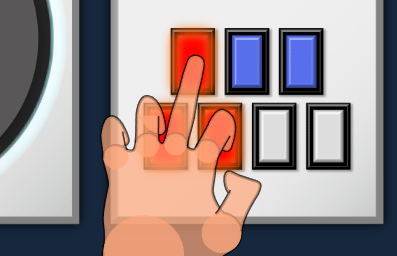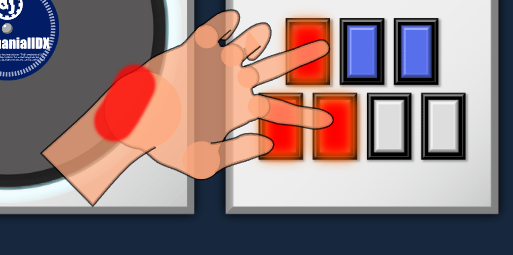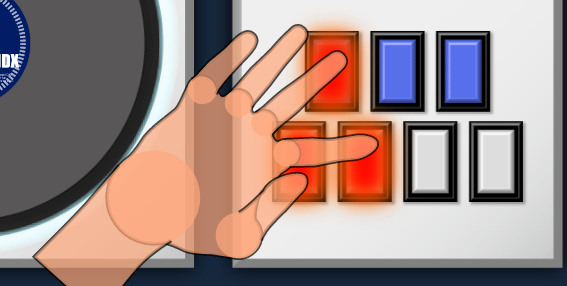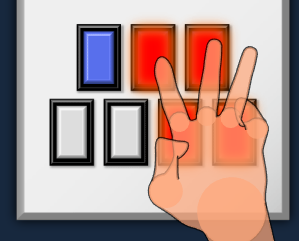Tips for Beginners
Table of contents
Click here to flip 1P / 2P view.
Tips to improve your skills
Following these are strongly recommended if you want to have an easier time improving your skills. You can choose to not follow them - some players find joy in discovering things as they play the game! But if you are looking for pointers, here you go.
Never use auto scratch
This is a common pitfall. You may be tempted to turn on auto scratch because you think you’ll “learn to scratch later” or “want to focus on notes first”. This is not the way to learn the game! The entire point of single player IIDX is to hit the notes while also hitting the turntable. There is never a really a case where turning on auto scratch is beneficial. Keep it off!
Practice pinky scratch
You may have heard of the term “pinky scratch” - but in reality this is more about using your ring and/or pinky fingers to turn the turntable. This is in contrast to completely lifting your hand away from the keys for the turntable, which was actually common during 5-key beatmania days!

The idea of pinky scratching is to have most of your hand stay on some of the keys, and reaching out your ring/pinky fingers to also use the turntable. This is a critical skill that you must learn.
Use your thumbs
If you are coming from other rhythm games, especially ones you play with keyboard - you might not be using both thumbs. You should be using both left and right thumb! The thumb is your strongest finger, it would be a waste if you didn’t use them.
Turn on timing display (FAST/SLOW)
It is strongly recommended that you enable the timing display, so that you can get a sense of how late or early you are hitting. This is found in the advanced options menu (blue menu).
Find a comfortable hi-speed setting
Once you feel ready, switch from normal hi-speed to floating hi-speed option. Find a comfortable green number that allows for enough reaction time, but not too much that you’re looking at too many notes on the screen.
For beginners, you should aim for a green number between 300-350. Over time, as you improve your ability to read, you can lower it to around 290-300.
Play a variety of charts
It is important that you play through a diverse set of patterns during your session. Don’t waste your time trying to EX-HARD clear a level 3. Move on and enjoy a different song.
Avoid bad playstyles
Avoid hunt & peck method
Avoid the “hunt and peck” method - moving your hand around and using your index or middle finger to press each key - commonly referred to as hokuto (北斗) method. In western communities this is sometimes referred to as “freestyle” - although the term freestyle is ill-defined and misleading - but that’s besides the point.
You will quickly become overwhelmed as you progress to higher levels! Yes, there are people who can play level 12’s with this style, but that doesn’t mean it’s an ideal one. You will have an immensely difficult time with the game if you don’t learn at least one static playstyle.
Try not to use the “claw” playstyle.
This is the playstyle where your turntable hand uses ring finger, middle finger, and index finger to hit buttons 1-3. New players that come from keyboard-based rhythm games naturally gravitate to this playstyle, as it maps 1:1 to a linear layout on the keyboard (e.g., S D F space J K L).

The issue with this playstyle is that:
- you are not using your left thumb, which is bad as explained above
- it requires a lot of hand movement for the left hand to move into the scratching position.
Yes, there are top rankers who use this style, but they are a tiny minority.
Try not to “wrist”… for now
Wristing is when you use the wrist - or the bottom part of your palm - to turn the turntable. When not scratching, it rests naturally on top of the turntable.

While this is a method that is commonly used by high-level players, including many top rankers - it’s really unnecessary if you are a beginner; in fact, it could give you bad habits. Wristing was a skill that started from BMS players playing insane BMS on PS2 KOC controller, which has a small, flat turntable that is much closer to the keys; it was a necessary skill that arose from a combination of extremely high density charts + a controller that is easy to wrist on.
The level of charts you are playing as a beginner do not call for wristing, it should be sufficient to use your fingers to scratch. Even if you feel that you are having difficulties reaching for the turntable, don’t be tempted to start wristing just yet, try to figure out how you can be more flexible & adaptable when scratches show up.
What is the ideal playstyle for beginners, then?
Here is a suggestion as to how you could be playing, but feel free to experiment with other popular playstyles! Also feel free to check out the playstyles page which has more details on other common styles.
Scratch-side hand
Thumb Slide aka 3/5 (Strongly recommended for beginners)

Thumb on 1 and 3, and index finger on 2. Note that you are moving your left thumb around to hit button 1 or 3, using the tip of your thumb.
Some people call this 3/5, as the left hand covers buttons 1-3, and the right hand covers buttons 3-5. Japanese people call it thumb slide.
Why this style for beginners?
- It is easy to learn (vs. 1048, for example, which has a bit of a learning curve)
- It is a perfectly fine primary playstyle that could possibly carry you to Kaiden level, if you wish.
- Even if you end up switching to a different style later on (e.g., 1048 or TAKA.S), this is a very useful style to fall back onto when you need to scratch and hit notes at the same time. Most high-level players switch between a primary and a secondary playstyle, depending on the situation.
1048 (Sometimes recommended for beginners but difficult to learn)

Thumb on 1, middle finger on 2, and index finger on 3.
It is also useful to start learning 1048 if you wish. This style is extremely useful for high density charts that you will be facing as you go into higher level charts. The downside is that it has a steep learning curve initially due to it’s somewhat unnatural formation.
However – it is not yet necessary as a beginner. It’s just that if you can get used to this early on, you will benefit later on when it is time to learn it.
The other hand
For right hand (left hand if you’re 2p player), you only really have two choices. While pinky on 7 is more encouraged, you should pick one that feels more natural to you.
In either case, you should be flexible enough to hit 3 with your thumb when the situation calls for it.
Pinky on 7 (Recommended)

Index on 4, thumb on 5, middle on 6, and pinky on 7. Ring finger is normally not used.
Why is this one recommended over ring on 7? For most people, it seems like using the pinky is less tiring than ring finger, and the pinky tend to be more independent in terms of movement. This is a personal preference, of course.
There is a variation of called “flat pinky” where you use the side of your pinky instead of the tip. Some people find this more comfortable.
Ring on 7

Index on 4, thumb on 5, middle on 6, and ring finger on 7. Pinky is normally not used.
Other styles
Please check out the playstyles page.
